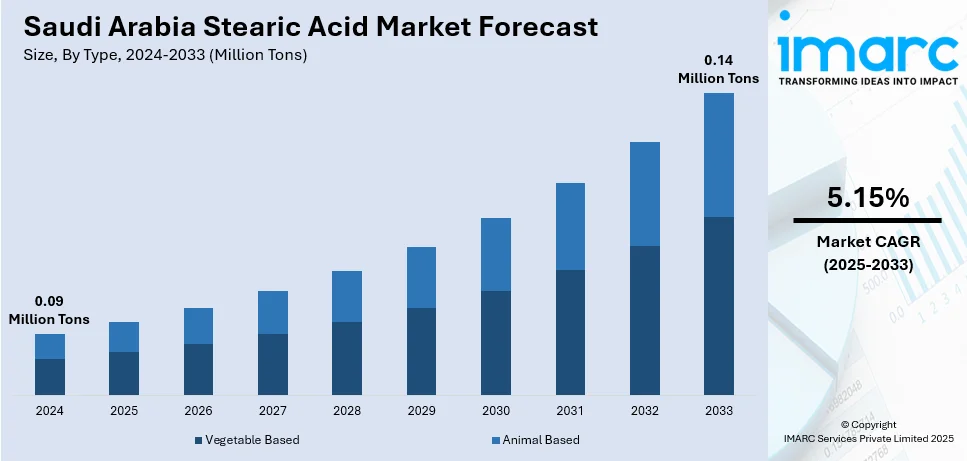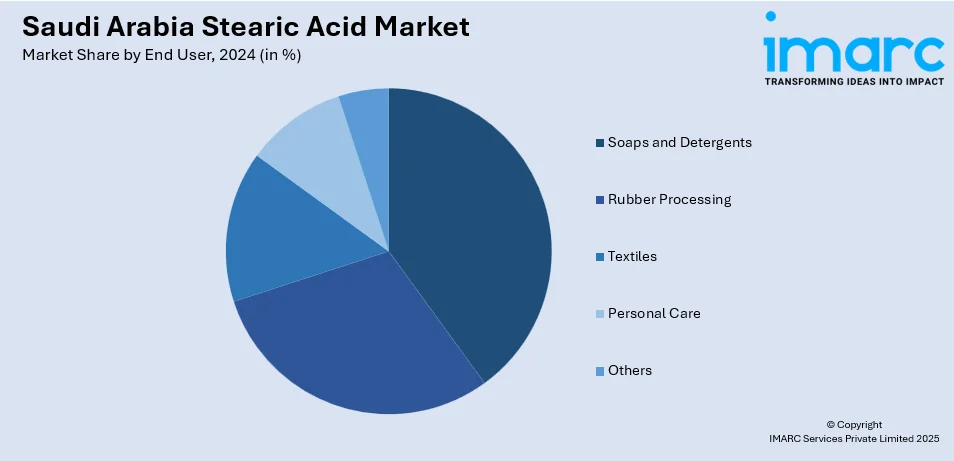
Saudi Arabia Stearic Acid Market Size, Share, Trends and Forecast by Type, End User, and Region, 2025-2033
Saudi Arabia Stearic Acid Market Overview:
The Saudi Arabia stearic acid market size reached 0.09 Million Tons in 2024. Looking forward, IMARC Group expects the market to reach 0.14 Million Tons by 2033, exhibiting a growth rate (CAGR) of 5.15% during 2025-2033. The market is driven by rising demand from the personal care and cosmetics sector, fueled by increasing disposable income and preference for natural ingredients. Additionally, growth in the food industry, supported by urbanization and government initiatives such as Vision 2030, boosts consumption. Expanding local manufacturing and foreign investments are further expanding the Saudi Arabia stearic acid market share, creating opportunities for suppliers.
|
Report Attribute
|
Key Statistics
|
|---|---|
|
Base Year
|
2024 |
|
Forecast Years
|
2025-2033
|
|
Historical Years
|
2019-2024
|
| Market Size in 2024 | 0.09 Million Tons |
| Market Forecast in 2033 | 0.14 Million Tons |
| Market Growth Rate 2025-2033 | 5.15% |
Saudi Arabia Stearic Acid Market Trends:
Rising Demand for Stearic Acid in Personal Care and Cosmetics
The market is experiencing significant growth due to increasing demand from the personal care and cosmetics industry. Stearic acid is a key ingredient in products, including soaps, lotions, and creams, due to its emulsifying and thickening properties. With the Kingdom's expanding population and rising disposable income, consumers are spending more on premium skincare and haircare products. Saudi women, particularly those with high incomes, spend an average of SR 14,256 (approximately USD 3,800.65) annually on cosmetics, drawing global brands to the Kingdom. With skincare and make-up dominating the market, Saudi Arabia boasts the highest percentage of female consumers in the GCC region at 42%. This trend significantly impacts the demand for stearic acid, which is a key ingredient in cosmetic products. Additionally, the government's Vision 2030 project is pushing local production in the nation, resulting in more cosmetics production in the nation. This is also coupled with the preference of consumers toward naturally and organically made personal care products, where stearic acid may serve as the organic substitute for inorganic ingredients. With the penetration of international brands in the market and domestic players diversifying their product range, the demand for high-quality stearic acid is likely to grow at a consistent rate.

Expansion of the Food Industry Driving Stearic Acid Consumption
The increasing usage in the food industry as a stabilizer and emulsifier is significantly supporting the Saudi Arabia stearic acid market growth. Stearic acid is commonly used in food processing for products such as margarine, confectionery, and baked goods to enhance texture and shelf life. The Kingdom's food sector is growing rapidly due to rapid urbanization, a rising middle class, and an influx of expatriates, leading to higher consumption of processed and packaged foods. Additionally, the government's focus on food security and local production under Vision 2030 is encouraging investments in food manufacturing, further increasing the demand for food-grade stearic acid. An industry report shows that dates attain a high 119% self-sufficiency in vegetable products, and shrimp is at the top in animal products with a self-sufficiency level of 147%. With growing food security, critical ingredients such as stearic acid are increasingly relevant in food production in Saudi Arabia, especially in the dairy and processed foods industry. The report highlights a significant increase in consumption, with per capita rates indicating rice consumption at 45.77 kg annually and milk at 70.19 liters annually. With the growing trend of health-conscious consumers, manufacturers are also incorporating stearic acid in fortified and functional foods, thereby creating new opportunities for market growth. This expansion in the food industry is expected to drive sustained demand for stearic acid in Saudi Arabia.
Saudi Arabia Stearic Acid Market Segmentation:
IMARC Group provides an analysis of the key trends in each segment of the market, along with forecasts at the country and regional levels for 2025-2033. Our report has categorized the market based on type and end user.
Type Insights:
- Vegetable Based
- Animal Based
The report has provided a detailed breakup and analysis of the market based on the type. This includes vegetable based and animal based.
End User Insights:

- Soaps and Detergents
- Rubber Processing
- Textiles
- Personal Care
- Others
A detailed breakup and analysis of the market based on the end user have also been provided in the report. This includes soaps and detergents, rubber processing, textiles, personal care, and others.
Regional Insights:
- Northern and Central Region
- Western Region
- Eastern Region
- Southern Region
The report has also provided a comprehensive analysis of all the major regional markets, which include Northern and Central Region, Western Region, Eastern Region, and Southern Region.
Competitive Landscape:
The market research report has also provided a comprehensive analysis of the competitive landscape. Competitive analysis such as market structure, key player positioning, top winning strategies, competitive dashboard, and company evaluation quadrant has been covered in the report. Also, detailed profiles of all major companies have been provided.
Saudi Arabia Stearic Acid Market Report Coverage:
| Report Features | Details |
|---|---|
| Base Year of the Analysis | 2024 |
| Historical Period | 2019-2024 |
| Forecast Period | 2025-2033 |
| Units | Million Tons |
| Scope of the Report |
Exploration of Historical Trends and Market Outlook, Industry Catalysts and Challenges, Segment-Wise Historical and Future Market Assessment:
|
| Types Covered | Vegetable Based, Animal Based |
| End Users Covered | Soaps and Detergents, Rubber Processing, Textiles, Personal Care, Others |
| Regions Covered | Northern and Central Region, Western Region, Eastern Region, Southern Region |
| Customization Scope | 10% Free Customization |
| Post-Sale Analyst Support | 10-12 Weeks |
| Delivery Format | PDF and Excel through Email (We can also provide the editable version of the report in PPT/Word format on special request) |
Key Questions Answered in This Report:
- How has the Saudi Arabia stearic acid market performed so far and how will it perform in the coming years?
- What is the breakup of the Saudi Arabia stearic acid market on the basis of type?
- What is the breakup of the Saudi Arabia stearic acid market on the basis of end user?
- What is the breakup of the Saudi Arabia stearic acid market on the basis of region?
- What are the various stages in the value chain of the Saudi Arabia stearic acid market?
- What are the key driving factors and challenges in the Saudi Arabia stearic acid market?
- What is the structure of the Saudi Arabia stearic acid market and who are the key players?
- What is the degree of competition in the Saudi Arabia stearic acid market?
Key Benefits for Stakeholders:
- IMARC’s industry report offers a comprehensive quantitative analysis of various market segments, historical and current market trends, market forecasts, and dynamics of the Saudi Arabia stearic acid market from 2019-2033.
- The research report provides the latest information on the market drivers, challenges, and opportunities in the Saudi Arabia stearic acid market.
- Porter's five forces analysis assist stakeholders in assessing the impact of new entrants, competitive rivalry, supplier power, buyer power, and the threat of substitution. It helps stakeholders to analyze the level of competition within the Saudi Arabia stearic acid industry and its attractiveness.
- Competitive landscape allows stakeholders to understand their competitive environment and provides an insight into the current positions of key players in the market.
Need more help?
- Speak to our experienced analysts for insights on the current market scenarios.
- Include additional segments and countries to customize the report as per your requirement.
- Gain an unparalleled competitive advantage in your domain by understanding how to utilize the report and positively impacting your operations and revenue.
- For further assistance, please connect with our analysts.
 Request Customization
Request Customization
 Speak to an Analyst
Speak to an Analyst
 Request Brochure
Request Brochure
 Inquire Before Buying
Inquire Before Buying




.webp)




.webp)












